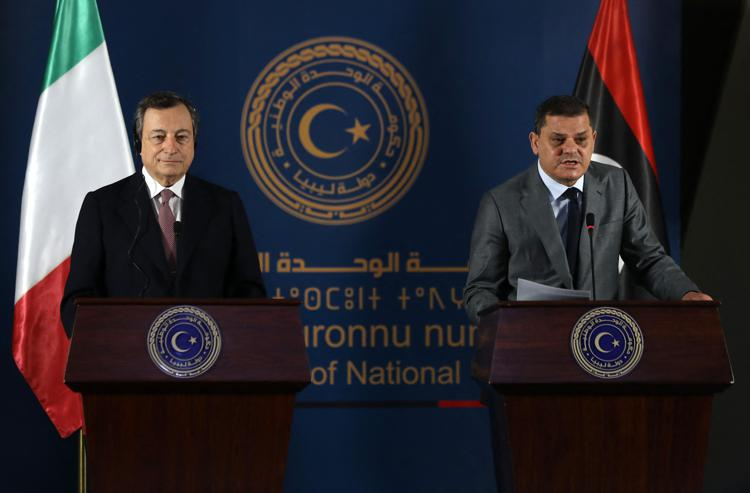Address
304 North Cardinal St.
Dorchester Center, MA 02124
Work Hours
Monday to Friday: 7AM - 7PM
Weekend: 10AM - 5PM
Address
304 North Cardinal St.
Dorchester Center, MA 02124
Work Hours
Monday to Friday: 7AM - 7PM
Weekend: 10AM - 5PM


On April 6th Italian Prime Minister Mario Draghi has flown to Tripoli where he has met his Libyan counterpart Abdul Hamid Dbeibah. This was Draghi’s first international trip since taking office in February and its significance may point to a change in the Italian stance towards Libya. Italian Minister of Foreign Affairs Luigi Di Maio was also present, after having visited Libya twice at the end of March. The Italian delegation met also with Mohamed al-Menfi, president of the Libyan Presidential Council, and the two vice-presidents. Talks between the two prime ministers have covered efforts to stabilise the country, projects to rebuild infrastructure, economic cooperation and immigration. Draghi has also expressed Rome’s support to Libya’s newly found national unity, stressing the need to maintain the ceasefire put in place since October 2020 and the urgency of withdrawing foreign troops still present in the country. Italian participation in reconstruction projects will include repairing the Tripoli airport, currently damaged and inoperative, and the construction of a 1750 km-long highway connecting the capital Tripoli to the city of Benghazi in the east of the country, as well as agreements in the energy sector, by far the most important in the Libyan economy. Italy has also pledged to help its southern neighbour in the fight against the current COVID-19 pandemic. This visit has followed a joint trip made by the foreign ministers of France, Germany and Italy on March 25th, in a clear attempt to enhance Europe’s role in the country through economic development and foreign investment after years of Russian and Turkish predominance thanks to their military interventions. On the same note, on April 5th, one day before Draghi’s visit, both Aeneas, the consortium of Italian firms that will likely be tasked with building the aforementioned coastal highway, and ENAV, the Italian air navigation service provider, had also sent a delegation to Tripoli, the latter with the objective to reactivate flights between the two countries.
It is important to remember that, despite business visits and diplomatic delegations, Libya’s situation is still extremely fragile and the path to stability is long and possibly uncertain. However, the situation has sensibly improved with the end of the fighting in October 2020. Since 2014 Libya had hosted two rival governments, one in Tripoli headed by Fayez al-Sarraj, and its rival in Tobruk, in the east of the country, led by Field Marshall Khalifa Haftar. The latter, supported by Russia, in 2019 started a military campaign to capture the capital, but was eventually repelled thanks to Turkey’s intervention in favour of the Tripoli government. After a Turkish-Tripoline counter-offensive ended in stalemate, talks have been held and a ceasefire has been in place since October 2020. On March 15th, a new government of national unity, accepted by both rivals, has been formed with the task of bringing the country to elections in December 2021. The proclamation of the first unified Libyan government since 2014, led by Dbeibah, has been positively welcomed by many, including most of the foreign actors supporting opposing sides in the civil war. In the same week the Italian delegation arrived in Tripoli, the prime ministers of Malta and Greece, as well as European Council President Charles Michel have all visited the Libyan capital. Moreover, in the last two months many countries have reopened their embassies in the country, or plan to do so in the near future. The French embassy reopened at the end of March after it was closed down and moved to Tunis in 2014, while the European Union, Greece, Malta and Egypt have followed the French example. The Italian embassy in Tripoli had already reopened in 2017 and now plans are underway to do the same with its consulate in Benghazi. However, Libya’s return to normalisation is hampered by the ongoing presence of foreign troops in the country, whose date for withdrawal, January 23rd, has gone largely unnoticed. The foreign presence is estimated at around 20000 fighters, including Turkish forces controlling the al-Watiya airbase and naval facilities in Misrata, as well as Russian mercenaries from the Wagner Group based in Sirte, where they have dug a 70 km-long fortified trench. It is clear that foreign military presence represents a grave threat to a pacific transition and normalisation in the country.
Italy seems to be pursuing its interests with clearer objectives and a more coherent agenda compared to the past years, trying to play a more definite role in the Libyan scenario. For years Italy, while supporting the al-Sarraj government, had been in favour of a diplomatic solution to the conflict but had acted mostly in a UN or NATO framework, with the result of letting more distant foreign actors, above all Russia and Turkey, become the key players thanks to the size and strength of their military intervention. However, Libya’s northern neighbour now is increasingly more willing to exploit its economic leverage (which neither Russia nor Turkey have) to gain a leading role in Libya’s post-war reconstruction and pacification. A pacified Libya would greatly affect many of the key Italian interests in the southern Mediterranean, including terrorism prevention, safeguard and improvement of energy infrastructure and management of migration routes. Migration, in particular, has been and remains a hot topic, with an estimated 350 people dying in the Central Mediterranean route in 2021 alone, including last week after a dinghy carrying 130 people capsized off the Libyan coast.
Notifications